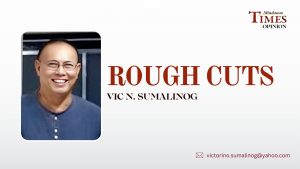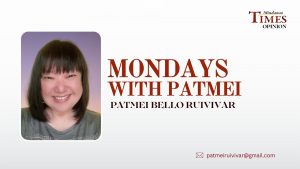By Carmela Marie Santos
DAVAO CITY (MindaNews) — July marks the second month of the closed fishing season in Davao Gulf.
Since 2014, schools of fish are given a break from June to August by the Bureau of Fisheries and Agriculture (BFAR): no municipal or commercial fishing is allowed in the gulf.
Hold the paksyo or prito for now of your favorite Alumahan/karabalyas (mackerel), Matambaka (big-eyed scad), Galunggong (scad) and Bilong-bilong (moonfish) – collectively known as pelagic fish (living in the imaginary column between the surface of the sea and the bottom). Let them swim free to grow in size and numbers.
Replenishment of fish stocks is the goal since overfishing is identified as one of the culprits in diminishing fish productivity in Davao Gulf.
Between 2022 and 2023, a 17% increase in landing catch was reported and BFAR XI attributes this to a “positive trend in fish production of small pelagic fish in the Gulf.” If this is indicative of the fruits of the closed season policy on top of monitoring: well and good!
Another good practice was observed by fisherfolk surrounding Barangay Hizon.
In 2018, they observed a 30% increase in their fish catch, five years since Hizon declared a fish sanctuary in their area. [=The Hizon marine protected area (MPA) is nearly 3 hectares (2,700 square meters) and is a core zone or no-take area as defined in the Comprehensive Land Use Plan (CLUP) of Davao City 2019-2028.
In 2016 alone, of the MPA network in Davao City (and selected MPAs in Davao Gulf), Hizon MPA was in the honor roll: number one in terms of fish species (42) and Top 3 in terms of fish biomass (48 metric tons/square kilometer).
One might expect that as we bounce from the pandemic, fishing in Davao Gulf will flourish.
Not quite.
In October 2022, drilling activities commenced in the Hizon MPA area in relation to the Samal bridge (Samal Island Davao City Connector Project or SIDC).
A barge with a drilling platform stationed itself in various points in the area. Soil samples were taken for the detailed engineering design (DED) of the Project. At each station, the barge was anchored on its corners. Each anchor can easily destroy coral cover about “the size of a classroom” especially when the anchor is removed and a 50-meter rope entangled in corals will have to withstand the pull in all directions of a tugboat. This was the observation and documentation made by Davao-based marine biologist Dr. John Lacson in December 2022, when the barge anchored itself at the doorstep of Paradise Reef in Samal side. (Video available at: https://tinyurl.com/ParadiseAfter)
I remember asking Dr. Fred Medina, M.D. (professional scuba diver who serves the Philippine Commission of Sports Scuba Diving (PCSSD) to describe the corals carnage from the anchorage after he did a dive/photo documentation days later. He said, “well, they were amputated, avulsed and fractured.”
Makasayang ba.
When giant strides made by local government and line agencies for people-and-planet, others in national government take 10,000 steps back, waving a misleading banner of “priority national project.”
These projects rest easy on the appearance of regularity amidst gross irregularities in both process, design and impacts.
The Department of Public Works and Highways (DPWH) will just wave documents like a Certificate of No Objection signed by the Barangay Council of Hizon when asked why the take-off point in Davao City is the Hizon MPA.
Curiously, in an audience I was granted with the same barangay leaders in December 2022, they emphatically shared that they were assured by the consultants that the MPA will be left unharmed.
So where lies the lie?
BFAR on the other hand, as late as October and November 2022 was still not informed of the precise location and alignment of the SIDC bridge. They said they had made their own inquiry with the Project in December 2021.
If by February 2019, an alignment was pre-determined and by December 2020, an environmental compliance certificate (ECC) was issued for the Project, how come in that period BFAR was never consulted? What does three to four years of being left out in the dark mean for BFAR – and more importantly, for our fisherfolk?
How was the welfare of fisherfolk taken into consideration when they do not appear to have been part of the conversation? Will they remain an afterthought and just be put on the list of recipients of ayuda? Ayuda that is usually given in time of unexpected and natural disasters, where the assistance is temporary in nature.
Projects like this, while a pending disaster, is definitely not natural. And the impacts on livelihood cannot be temporary.
Cebu-based marine biology expert Dra. Filipina Sotto has described the destruction to be “irreversible, irreparable and incalculable” after she and her group conducted a study in 2019.[iii] She is joined by two other Davao-based marine biology experts, Dr. Lacson and Dr. Cleto Naňola (of UP Mindanao), in this expert opinion on the impact of the bridge construction on marine life and the reef.
Will it be a virtual “closed season” for the next four to five years of bridge construction and beyond?
One can only hope that it is not going to be off-season forever for our fisherfolk on both sides of Davao Gulf, for this project or any other project under the guise of “development.” They have barely survived the pandemic and are on post-pandemic recovery mode like us.
Meanwhile, swim free and strong fish friends!
It is also plastics-free July, may marine life in Davao Gulf be SuP-free forever.
PUHON.
Nota bene: When you grab that coffee (with a plastic lid) or that bag, or anything plastic packaging of food-and-drinks (even when you dine-in), please remember: what you throw away does not go away. There is no such thing as “away.” Remember the Second Law of Ecology: Everything must go somewhere.
Plastics find their way back to us – wrapped in fish (with microplastics in their bellies) sometimes.
Stay SuP-free, friends!
Fish be with you!
(MindaViews is the opinion section of MindaNews. Carmela Marie Santos is an environmental practitioner with a background in environmental science and management. She is a licensed environmental planner, a bike commuter and mother of three).




